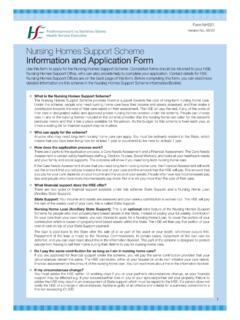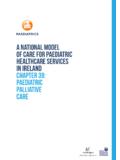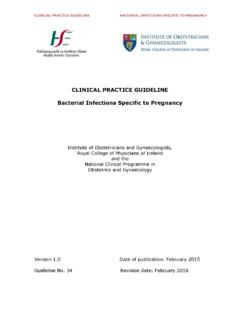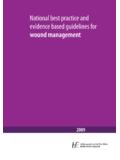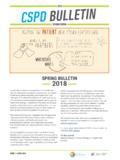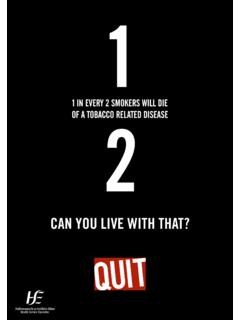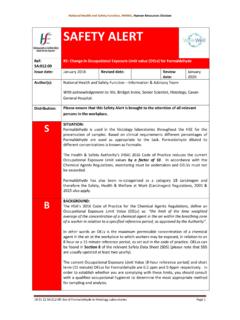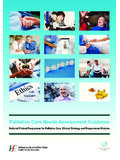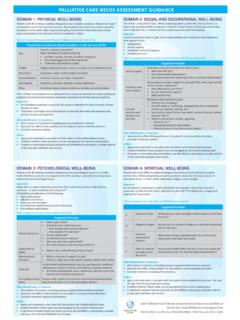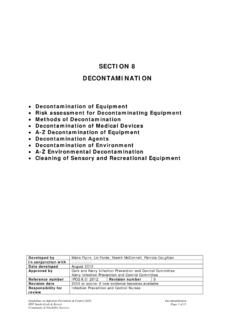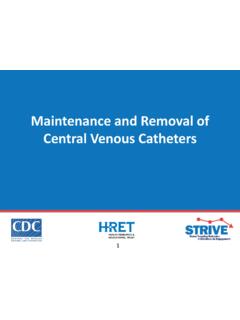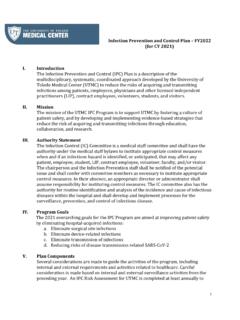Transcription of Hand Hygiene: Preventing avoidable harm in our care
1 hand hygiene : Preventing avoidable harm in our care hand hygiene Training Presentation for Healthcare Workers in Community and Primary Care National HSE HCAI AMR Clinical Programme 2017 What we will cover Why you should clean your hands What are Healthcare associated Infections The 5 Moments of hand hygiene The golden rules of hand hygiene hand hygiene and glove use hand hygiene Technique Learning outcomes Consider the current experiences for using hand hygiene in your workplace Understand
2 Why, how and where hand hygiene is important How to make improvements to achieve hand hygiene compliance that is safe The impact of HCAI on our patients HCAI can cause: more serious illness prolonged stay in a health-care facility long-term disability excess deaths high additional financial burden to health services high personal costs on patients and their families What are Healthcare Associated Infections An infection that is acquired after contact with healthcare services. Examples include Clostridium difficile (C diff.)
3 And methicillen resistant Staphylococcus aureus (MRSA) A bacteria commonly referred to as C diff which can be acquired after antibiotic use Spread from person to person or picked up in the environment/equipment or healthcare workers hands that is contaminated with C diff. (MRSA) can be transmitted from person to person or again from the healthcare workers hands , environment or equipment 5 6 Infectious Disease Any germs that can cause disease including bacteria viruses, parasites and fungus Reservoir Places where the germs can live and spread include food,water, toilet seat, door handles, human faeces and other body secretions Portal of Exit Where the germs leave the reservoir.
4 Includes the nose,mouth, back passage, urinary tract or blood and body fluids Mode of Transmission How the germs spread either by direct contact such as person to person by hands or indirect contact including the environment or equipment used to provide care Portal of Entry Where germs enter the body including open wounds catheters, feeding tubes cannulas,or mucous membranes Susceptible Host Persons at risk for getting an infection including elderly, young babies, people with chronic disease such as diabetes, asthma.
5 Having a wound or devices such as cannulas and catheters or feeding tubes in the body THE CHAIN OF INFECTION 7 For an infection to develop, each link of the chain must be connected. Remember breaking ANY link of the chain can stop the transmission of infection! Example of a HCAI which is preventable catheter associated urinary tract infections (CAUTI). By reducing the number of people that access or manipulate devices including catheters, cannulas and feeding tubes By ensuring that those that do make contact with devices, do it consistently correct Good hand hygiene practices will help reduce the risk of catheter associated urinary tract infection for the person that has the urinary catheter in place 8 What is hand hygiene ?
6 hand hygiene includes cleaning hands with alcohol-based hand rub (ABHR) or soap and water in order to remove germs, also known as microorganisms 9 So why and when should we clean our hands during our work? 10 Why we clean our hands Protect anyone receiving health care against harmful germs carried on your hands or germs present on the skin of the person you are providing care to Protect yourself and the environment from harmful germs 11 Germs present on resident/ clients skin and immediate environment surfaces Germs survive on hands for several minutes 12 hand hygiene not carried out or done correctly results in hands remaining contaminated Contaminated hands transmit germs via direct contact
7 With patient/resident or their immediate environment Germs transfer onto healthcare workers hands 2 3 4 5 1 Why is hand hygiene so important? One of the single most effective measures for Preventing the spread of infection and HCAIs If hand hygiene is done properly this can be over 90% effective in Preventing the spread of harmful germs and HCAIs Up to 70% (of some) HCAIs are preventable so hand hygiene is a very easy way to provide safer care 13 Where should you clean your hands ? hand hygiene is important in all places where health care is provided.
8 This includes hospitals, residential facilities and primary care settings including the patients home Busy health care providers need access to hand hygiene products where patient care is taking place Providing alcohol-based hand rub at the point of care (within arms reach) is an important system support to improve hand hygiene which is recommended as the most effective method providing hands are visibly clean 14 Adequate handwashing with water and soap requires 40 60 seconds Average time usually adopted by health-care workers: <10 seconds Alcohol-based handrubbing: 20 30 seconds.
9 Time constraint = major obstacle for hand hygiene 15 How does hand hygiene work? hand hygiene with alcohol-based hand rub correctly applied kills organisms in seconds in routine care. Exceptions are if hands are visibly dirty or when caring for someone with diarrhea who is suspect to have Clostridium difficile ( ) hand hygiene with soap and water done correctly removes organisms. 16 My 5 Moments for hand hygiene 17 18 My 5 Moments for hand hygiene Moment 1 Before Touching the patient/resident When Clean the hands before touching the person you are delivering care to Why To protect the perons recieving care from harmful micro-organisms carried on the HCWs hands Examples Helping someone to get washed or dressed Prior to changing incontinence wear Taking pulse, blood pressure, examination of skin.
10 Abdominal palpation 19 When- clean the hands immediately before performing an aseptic or clean procedure Why- to protect against micro-organisms from entering the persons body Examples Oral care, giving eye drops, suctioning Skin lesion care, wound dressing, giving an injection urinary catheter insertion and catheter care Accessing /commencing a tube feeding system Preparation of medication, or doing a dressing Taking specimen samples including blood and urine 20 Moment 2 Before a Clean/Aseptic Procedure When - clean the hands immediately after an exposure risk to body fluids (and after glove removal) Why - to protect the HCW and the healthcare environment from harmful micro-organisms Examples Clearing up urine, faeces, vomit, handling waste (soiled dressings, tissues, incontinence pads)
